“It is very important to keep this tradition alive” – Vardos at Appleby Fair
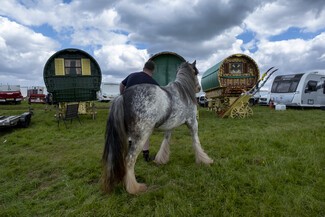
THE number of horse-drawn live-in wagons which travel to Appleby for the Fair continues to grow each year.
Almost 600 caravans in total were parked on Fair Hill by lunchtime on the first day, of which around a third were traditional, wooden and crafted carts.
Vardos were the original Gypsy caravan drawn by a Gypsy cob (horse). They are very seldom used now as they have been replaced by the modern trailer.
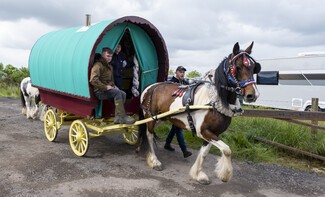
But they get wheeled out of storage in honour of tradition for Appleby.
Most Romany Gypsies call them Vardos, although some other traditions insist the word is Vada.
Romany Shera Rom Billy Welch calls them Open Lot, which defines those with a canvass front. Those with wooden doors on the front are known as Live-in Wagons.
In the South and East of England, where the terrain is flat, many are square topped. In the North they mostly come with bow-tops to make them lighter to get up the fells and hills.
But whatever they are called and whatever shape or size they come in; their popularity is increasing.
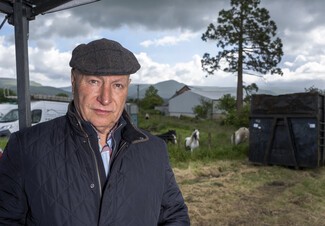
Billy Welch said: “90% of Gypsies and Travellers now live in houses, run businesses and the children go to a local school. But for two or three weeks a year, many want to return to the old way of life.
“That is what Appleby is all about, celebrating our traditions. About 140 of the 600 caravans on the hill this year are Vardos.
“Many use motor caravans, but more and more want to travel in bow tops. It is like antique cars – they are coming back into fashion.”
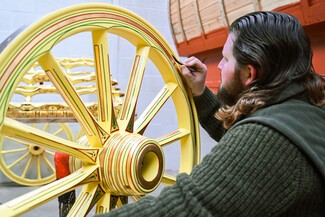
Billy explained that the ornately decorated Vardos appeared in the middle to late 19th century and Gypsies went back to their roots in Northern India for design.
He doesn’t own one himself but borrows a cousin’s when visiting schools to explain the Romany Gypsy way of life.
Pupils are particularly enthralled about how families lived in such tight spaces.
“There was a pull-out bed for the parents, the girls slept in a cupboard space under the one bed, and the boys slept outside the wagon, underneath with straw and bedding,” he explains.

Although very few Travellers still use the Vardos in this way, they are popular despite their cost.
“A good bow top will take five years to build and three years to paint and it takes artists. That is why they are so expensive.”
Prices seem to range from £10,000 for a self-build up to anything up to £100,000.
“They have to be repainted every year and stored carefully as the wood swells up in winter and shrinks as it dries in the summer.
“The wheels are particularly expensive as there aren’t many wheelwrights left. It is a highly skilled craft,” he adds.
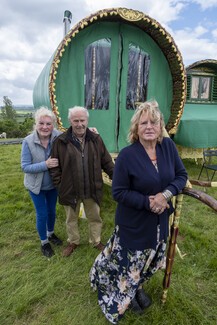
Matt and Ellen Howard, who met at Appleby, and describe themselves as English Gypsies, brought five “Vada” to this year’s Fair with their relatives.
Extended families travelling in convoys is a common feature of the fair and they travel the 40 miles from Bishop Auckland to Appleby every year.
“I have come every year all of my life,” says Matt, now 76.
“I have 25 horses on a smallholding, but we just bring two per wagon. We take two weeks over the journey, stopping off in Barnard Castle, Brough and Kirkby Stephen at the designated resting places. We like to take our time.
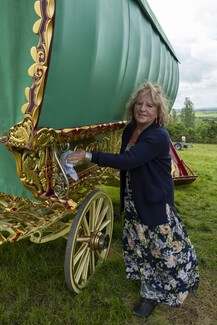
“We live in the wagons in summer months, but store them for the winter,” he adds.
Diane Nicholson, Ellen’s sister, said: “We all used to live all year round in the wagons, but that all had to stop. It is not safe.
“We now travel in the summer to various fairs and exhibitions and play the part for a few weeks, in order to keep the traditions alive. Appleby is the main venue.
“There are not so many craftsmen left, so we paint our own wagons, including the gold leaf. And it is the women’s job to clean them,” she says.
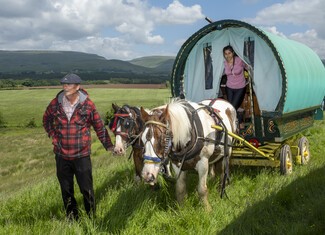
Glyn and Michelle Hewitt are unusual in that they live in their bow top all year round.
Glyn, aged 60, who describes himself as an English Traveller, takes two months to travel the 60 miles from his Middlesbrough campsite to Appleby.
“We like to stop off and meet people from different cultures. Some of them are friendly. Some are not.”
He bought his current bow top at Appleby 16 years ago. He maintains it himself, re-sheeting and stretching the canvass afresh each year.
“It’s our tradition. No matter what the authorities do, there will always be those who want to live and travel on the roads.
“It is very important to keep this tradition alive,” adds the father-of-seven.
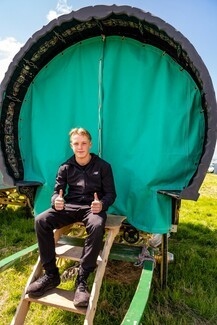
A quicker, if longer, journey faced the Lowther and Ewbank clan from Bradford. They brought four bow tops the 115 miles from Bradford in West Yorkshire in just over a week.
They also maintain their own bow tops, originally built by cousins, the Dugdales of Burton-in-Kendal.
Keen to keep the tradition alive is Ady-Lee Lowther, aged 16, who said: “I enjoy coming to Appleby every year. It is fun and I am keen to keep up the family tradition,” he says.
It seems the future of live-in, horse-drawn wagons is secure – whatever they are called.
Report by Mike Glover, exclusive for the Travellers’ Times
(Lead photograph: Appleby Fair - Fair Hill 2024. Photograph by Milton Haworth)